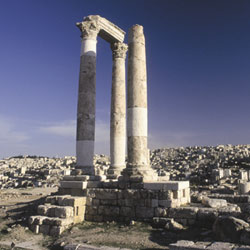|
AmmanAmman, Known as Rabbath-Ammon during the Iron Age and later as Philadelphia, is the capital city of the Hashemite Kingdom of Jordan, and the administrative capital and commercial center of Jordan. The city was originally built on seven hills, but now it spans over an area of nineteen hills, known as a “jabals” or "mountains". Amman is referred to as the white city due to its low size canvas of stone houses.
The Citadel, which dates back to Roman and Byzantine times, includes many structures such as the Temple of Hercules, the Omayyad Palace and the Byzantine Church. At the foot of the Citadel lies the 6000 seat Roman Theatre which is a deep-sided bowl carved into the hill and still used for cultural events. Another newly restored theatre is the 500-seat Odeon which is used for concerts. The three museums found in the area offer a glimpse of history and culture, they are the Jordan Archaeological Museum, The Folklore Museum and the Museum of Popular Tradition.
|
 Much of Amman's tourism is focused in the older downtown area, which is centered around the old Souq “traditional market” and the King Hussein Mosque. For tourists seeking the atmosphere of the Old City, it is best to venture to the district east of Jabal Amman. There, in the bustle of daily life, you can explore the capital's greatest souqs, fine museums, ancient constructions, monuments, and cultural sites.
Much of Amman's tourism is focused in the older downtown area, which is centered around the old Souq “traditional market” and the King Hussein Mosque. For tourists seeking the atmosphere of the Old City, it is best to venture to the district east of Jabal Amman. There, in the bustle of daily life, you can explore the capital's greatest souqs, fine museums, ancient constructions, monuments, and cultural sites.